Manchester United have been linked with bringing in an eventual successor to Nemanja Matić at the base of midfield for some time now, given that the Serbian will turn 33 next year.
The latest name doing the rounds in this regard is the Ecuadorian midfielder Moisés Caicedo.
The 19-year-old, who plays for Independiente del Valle in Ecuador, has also been reportedly scouted by Brighton, who are apparently ahead in the ‘race’ for his signature this month.
Despite being just 19, he has already been capped four times by his country and looks to be a star of the future.
In this scout report, we will examine Caicedo’s playing profile, strengths, and weaknesses to provide you with an overall assessment of the player and where he could fit in at his next club.
Moises Caicedo Style Of Play & Statistical Player Profile
Caicedo has largely been used as a central midfielder in his short senior career so far, but he has also played in defensive midfield and even at centre-back on a couple of occasions.
His career heatmap, provided by Wyscout, shows the areas where he has been predominantly active.
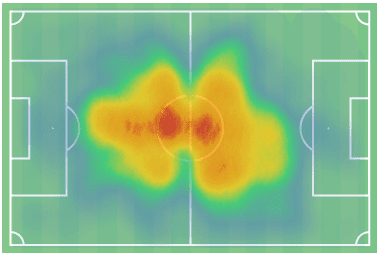
As we can see, Caicedo has primarily been responsible for the middle third of the pitch.
He has not necessarily been the deepest midfielder – he has often played as part of a midfield pivot as well, and therefore, he does advance to higher areas of the pitch when his team is in possession.
Generally, though, his role is to stay deeper and dictate, whether from his own half or from the opposition’s half, when his team has a sustained spell of possession and has pushed up the field.
As the heatmap shows, Caicedo is also tasked with protecting the central zone in front of his penalty area out of possession.
Statistically, there are quite a few interesting numbers from Caicedo’s career so far.
The first one is his pass completion rate.
Caicedo has an average pass success rate of 92.08% in his career so far, making just over 46 passes per 90 minutes.
This is an excellent rate by any metric, although it does not indicate anything about the nature and difficulty of those passes.
Looking deeper, however, we get the sense that the Ecuadorian is superb at ball retention.
He makes 11.53 forward passes per 90, on average, being successful with 84.2% of them, while the equivalent figures for sideways and backward passes are 27.18, 94.2% and 7.72, 96.5%, respectively.
Thus, we can see that even when passing forward, Caicedo is largely able to keep possession, which is a very important trait for a defensive midfielder.
Another metric to look at when assessing the potential threat that his passes can create is passes to the final third.
Caicedo averages 6.17 such passes per 90, with an accuracy rate of 85.8%.
Again, this shows that the 19-year-old is able to get the ball into relatively dangerous areas from his deeper midfield position fairly often and quite accurately.
Playing in a deeper role in midfield, he is not expected to provide the final killer pass or the pass which unlocks the defence, and this can be seen from a few metrics as well.
Caicedo only makes 1.32 passes per 90 into the penalty area and just 0.67 through passes per 90.
Thus, these numbers clearly show that Caicedo’s role so far in his career, both for Independiente and Ecuador, has been to facilitate play and retain possession rather than provide a direct creative threat.
Despite this, it is interesting to note his goal and assist numbers so far.
To date, Caicedo has scored eight goals and notched four assists in his senior career at a rate of 0.27 and 0.13 per 90 minutes, respectively.
Taken together, this gives him a goal involvement rate of 0.4 per 90 minutes, which is more than respectable for a defensive midfielder.
Taken over the course of a season, this would mean that the Ecuadorian would have around 16 goals and assists from 40 full games, which is excellent output from a player in his position.
It is also interesting to note that his career xG is at 4.44, while his career xA is 2.02.
He has outperformed on both these metrics, but given his role in the squad, that is more likely to be down to luck and his teammates’ excellent finishing rather than his own output.
This is borne out by our earlier passing statistics, as well as the fact that he has averaged just 1.21 shots per 90
minutes in his career so far and makes just 1.05 touches in the opposition penalty area per 90 minutes.
Nevertheless, this is an area to keep an eye out for, given that deep-lying midfielders who can also provide a goal threat are worth their weight in goal.
Finally, it would be instructive to look at his defensive numbers.
Of course, these will be conditioned by the amount of possession his team have had since higher possession would mean fewer opportunities to make tackles, interceptions etc.
Nevertheless, it is still an essential indicator of a player’s ability to be proactive and affect the game without the ball.
Caicedo makes 6.58 recoveries per 90 minutes, with more than 40% of them taking place in the opposition half.
This is merely a reflection of his deeper position in midfield and shows that he is primarily disciplined and is not asked to hunt for the ball upfield.
He has averaged 3.24 interceptions per 90 minutes
and engaged in 1.79 aerial duels per 90 minutes, winning nearly 57% of them.
These numbers show that Caicedo is a disciplined defensive midfielder, whose first job in possession is to keep the ball, rather than try to provide a defence-splitting pass.
In that regard, at least, he would be a suitable potential replacement for Matić, even though the Serbian has a much wider range of passing.
His defensive work, at least based on the numbers, seems to be more about positioning rather than getting into duels and tackles, which is again a good indicator for those considering him to be a Matić replacement.
We will now look at some in-game examples to better understand his style of play and attributes.
Moises Caicedo In possession
On the ball, Caicedo is generally reliable, able to keep possession with short passes either backwards or sideways, depending on the situation.
He is also good at playing quick, one-touch passes to get out of crowded areas and potentially advance the ball upfield.
However, on watching him play, it quickly becomes apparent that he likes to have time on the ball to pick a pass then, either out wide or ahead of him.
Switching the ball wide to the flanks to a winger or a full-back is also a favourite trait, and one he will often try if the opposition gives him the time and space to do so in a game.
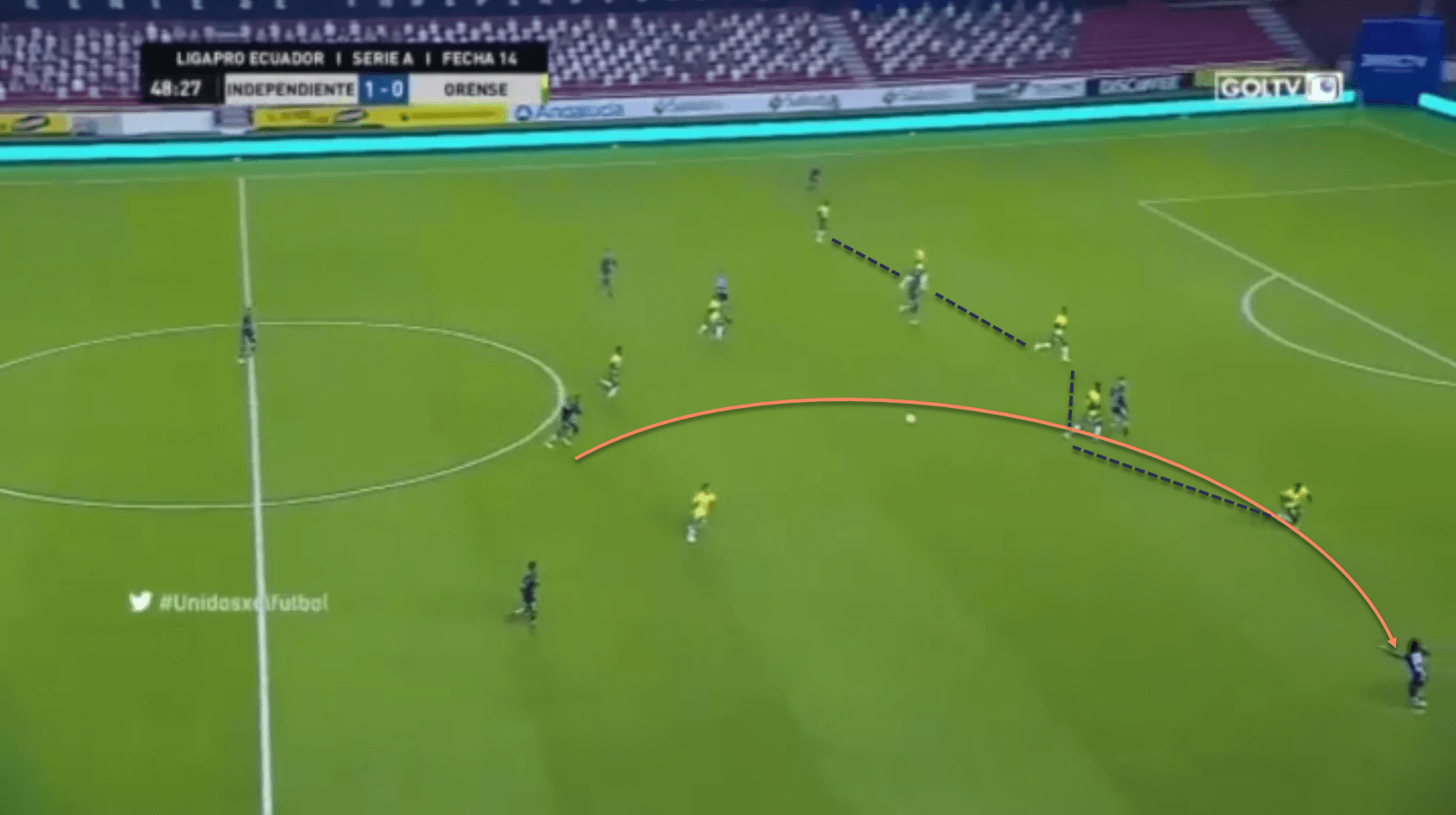
In this image, we can see that the opposition’s defensive line is relatively narrow, creating space for the winger out wide if he can be found in time, which Caicedo does.
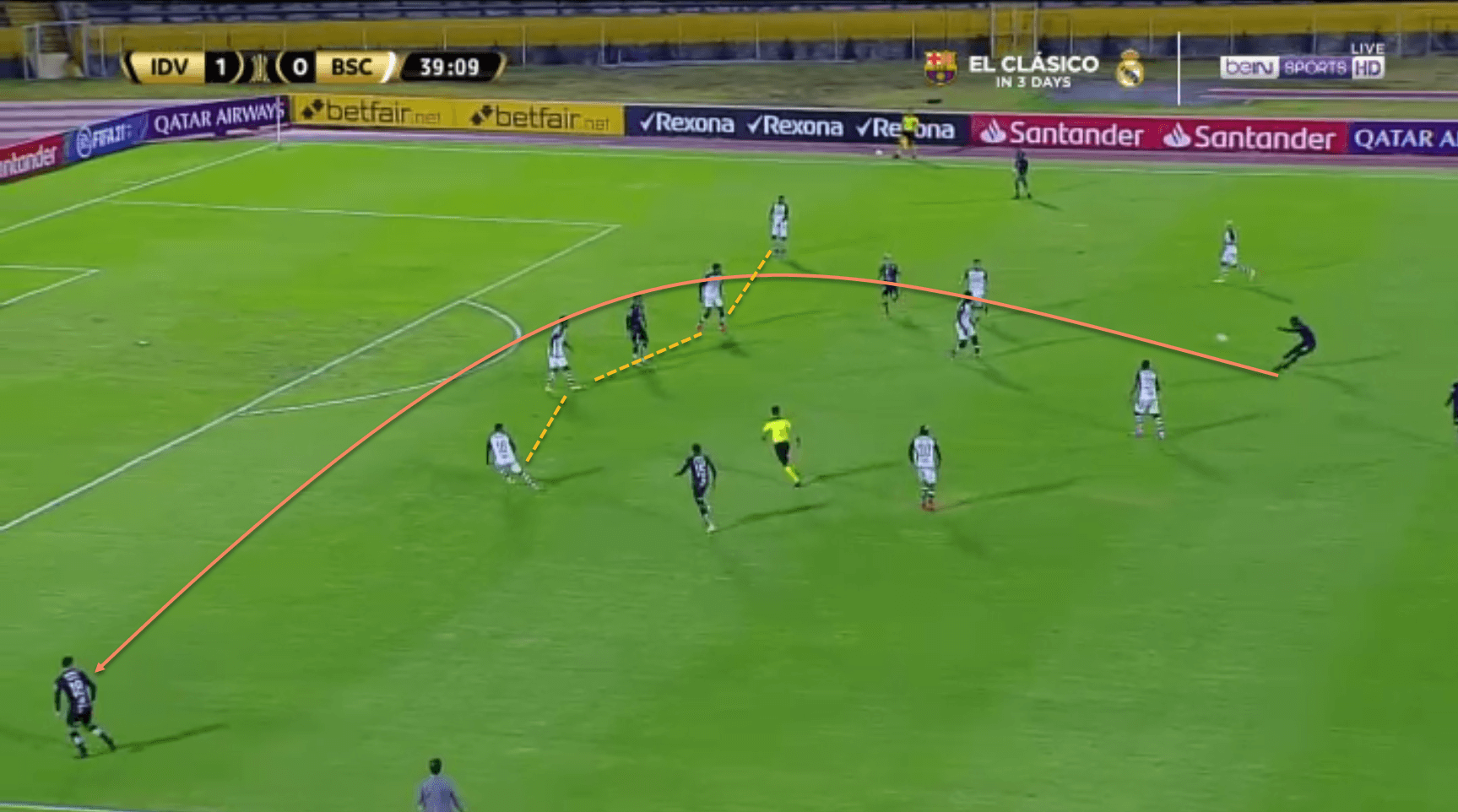
A similar situation, this time down the Independiente left flank – the opposition defence is exceptionally narrow, creating space for the full-back to run into if the ball is switched out to him.
Caicedo is also fond of pulling the strings from higher up the pitch, when the opposition is playing in a deep block and he is able to advance into their half.
This allows him to pick out runs into the box by his teammates over the defensive line.
The next couple of images are taken from the same game. Independiente was trailing, and the opposition had camped themselves in their own defensive third to try to see out the lead.
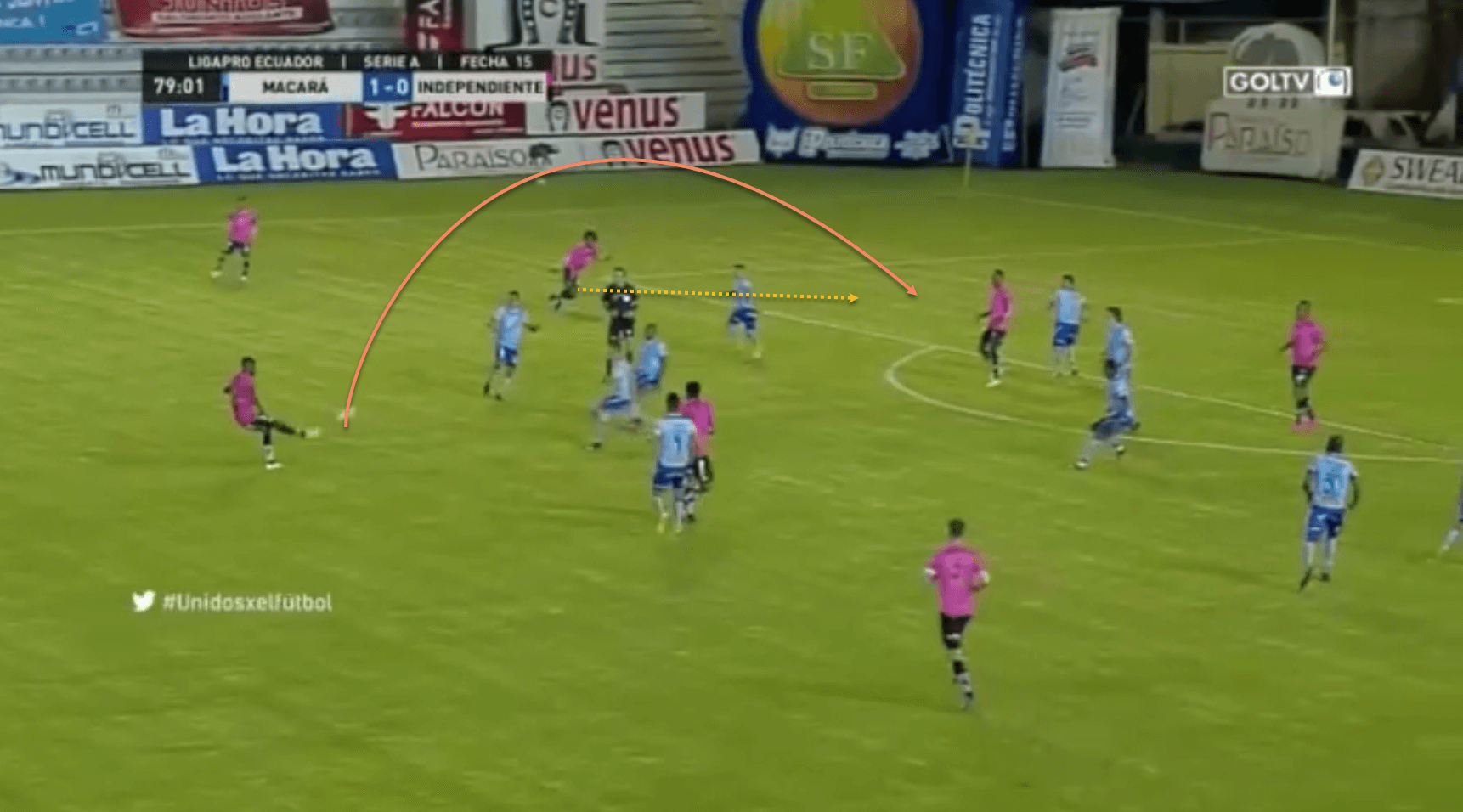
Notice how deep the opposition defence and midfield is.
This gives Caicedo plenty of time and space in front of the box to pick a pass, and he does so, chipping a ball into the box for the winger to run onto.
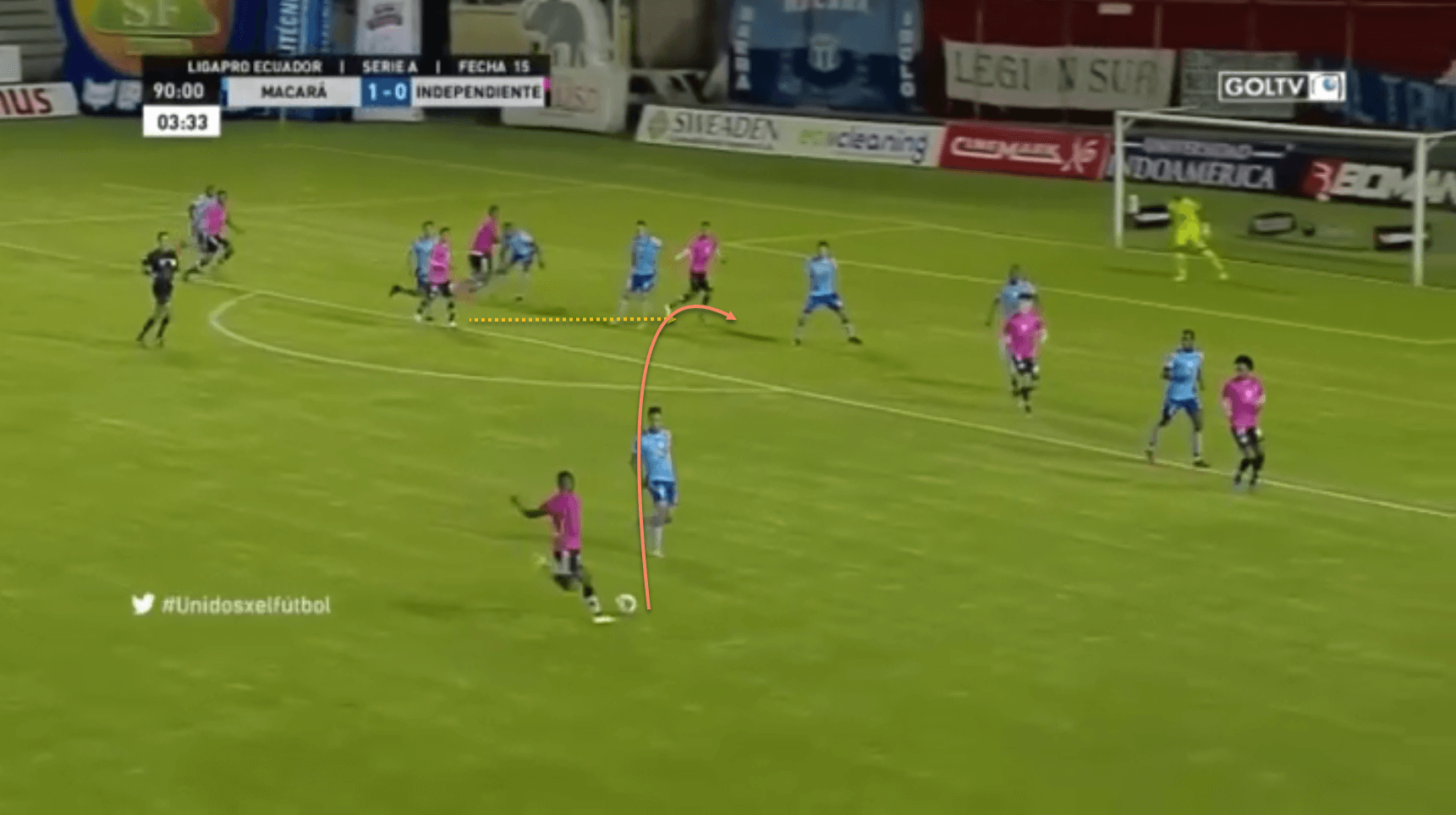
Here, Caicedo plays another dinked pass into the area, but for the deeper player on the edge of the box, who is able to get a looping header away but unfortunately off target.
These are just a couple of examples which show the Ecuadorian’s ability and willingness to be a playmaker when needed.
This is true when he is in his own half as well, as seen in the following image.
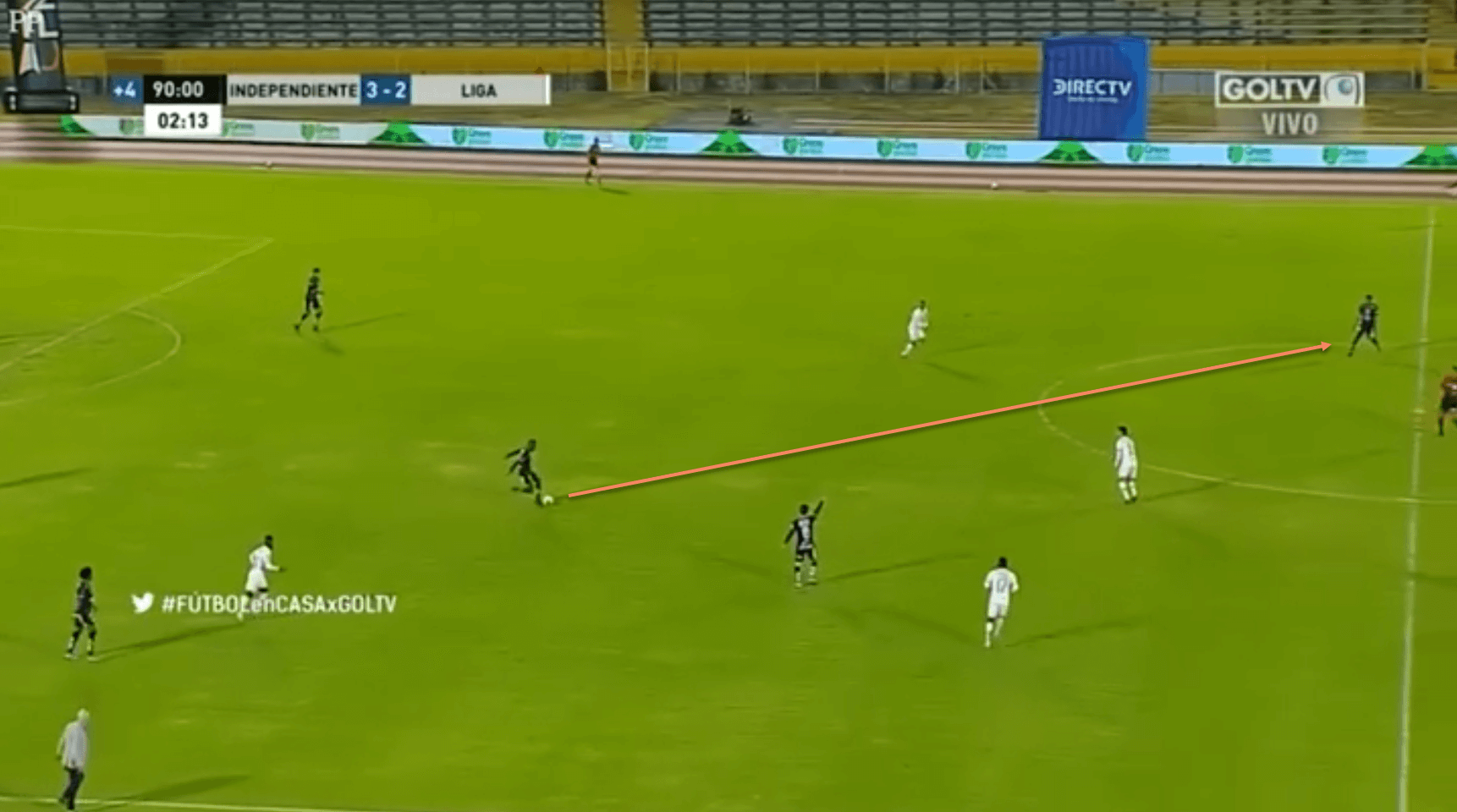
Caicedo receives the ball from his centre-backs, looks up, and plays a flat, whipped pass to his teammate, who is in space ahead of him and in position to launch an attack.
Note that the opposition is not pressing him at all, that Independiente is up 3-2 in stoppage time, and yet his instinct is to try to play an attacking pass.
This is not to say that he always plays a risky pass.
Far from it – the statistics mentioned earlier make it clear that he is reliable and safe in possession.
It only indicates that Caicedo is a player who is always looking for opportunities to create chances wherever possible, but he does not take undue risks in possession when the situation does not demand it.
Here is another example of his playmaking ability from a deeper position.
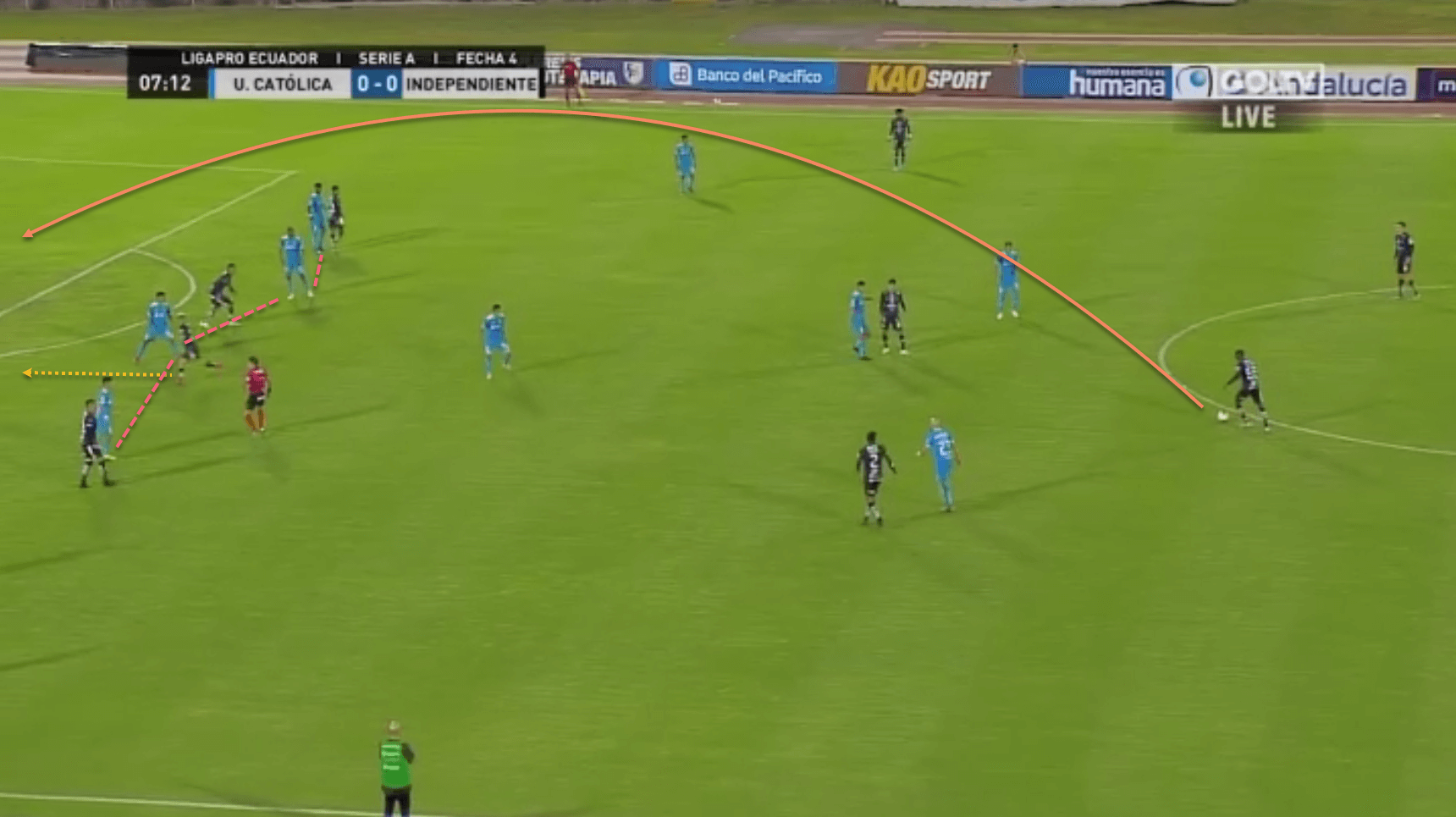
Once again, we see the 19-year-old pick up possession, under no pressure, just inside the opposition half, and then look for his teammate’s run in behind the opposition’s defensive line.
These examples are meant to show the Ecuadorian’s passing range, vision, and tendency to try to find teammates in dangerous positions when possible.
It is again worth reiterating that this is not something he does throughout a game.
It is only when such situations arise that he looks for a potential killer pass.
During buildup and when the opposition is pressing high, he looks to keep the ball moving with short, sharp passes and movement off the ball and rarely tries a risky pass when being pressured in his own half.
Caicedo does get forward to support the attack on occasion, and he is capable of playing quick combinations to move into space as well.
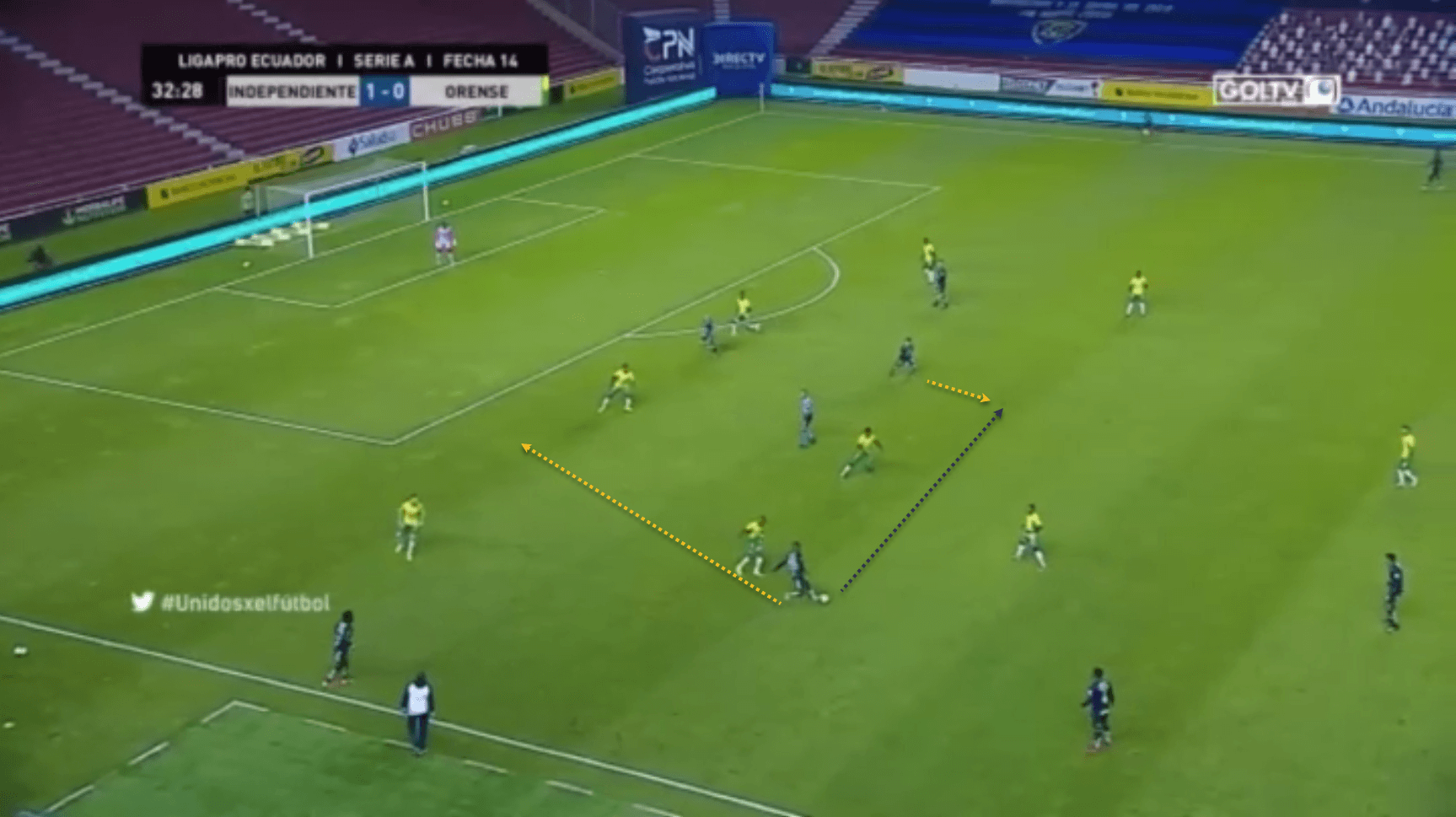
Here, he is in a slightly wider position on the left, from where he plays a pass infield before turning and darting into space…
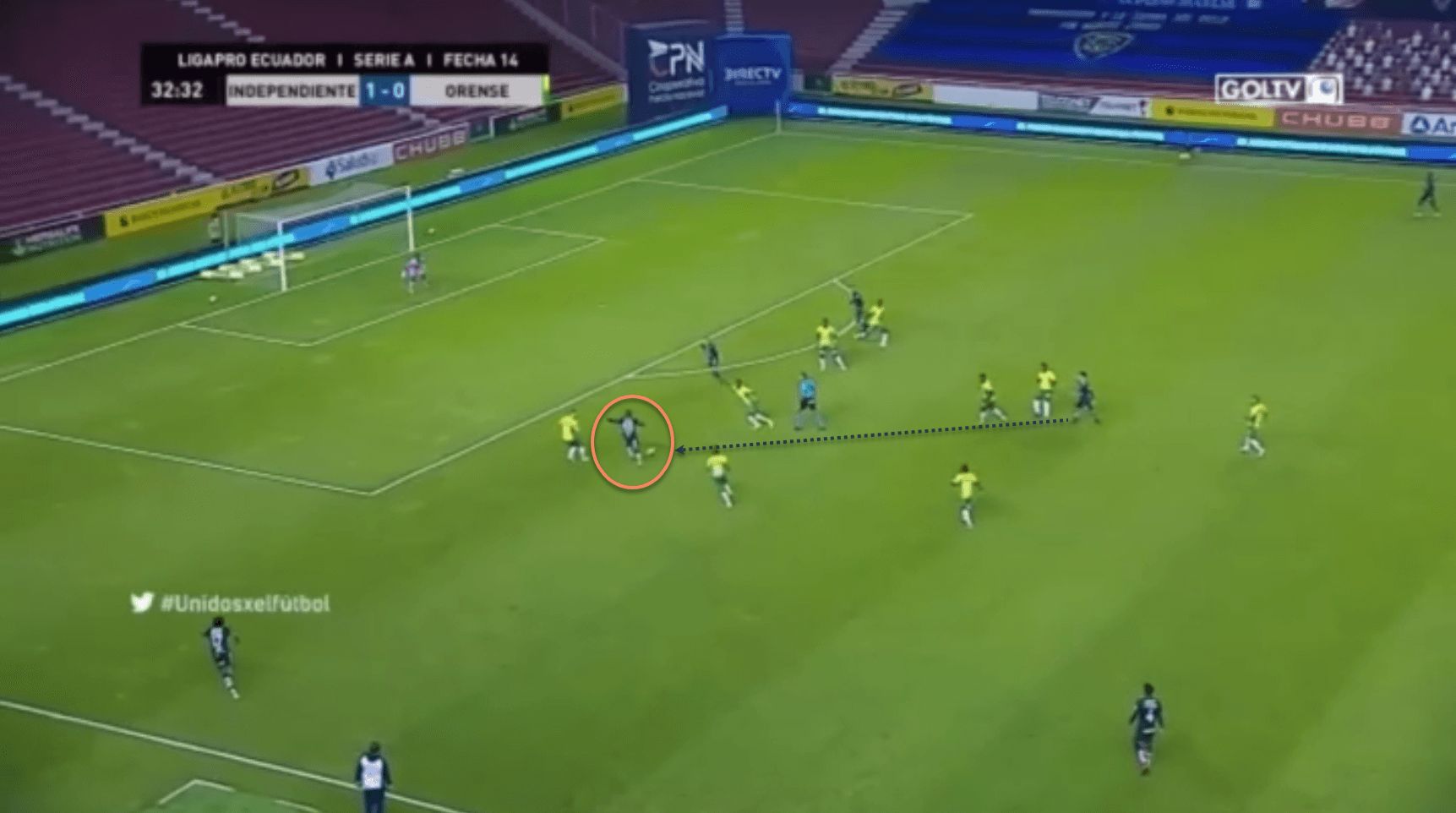
…which allows him to then receive the ball in a dangerous position just outside the penalty area.
His positioning when his team is in possession is not conservative – he does attempt to get into space and attack if possible.
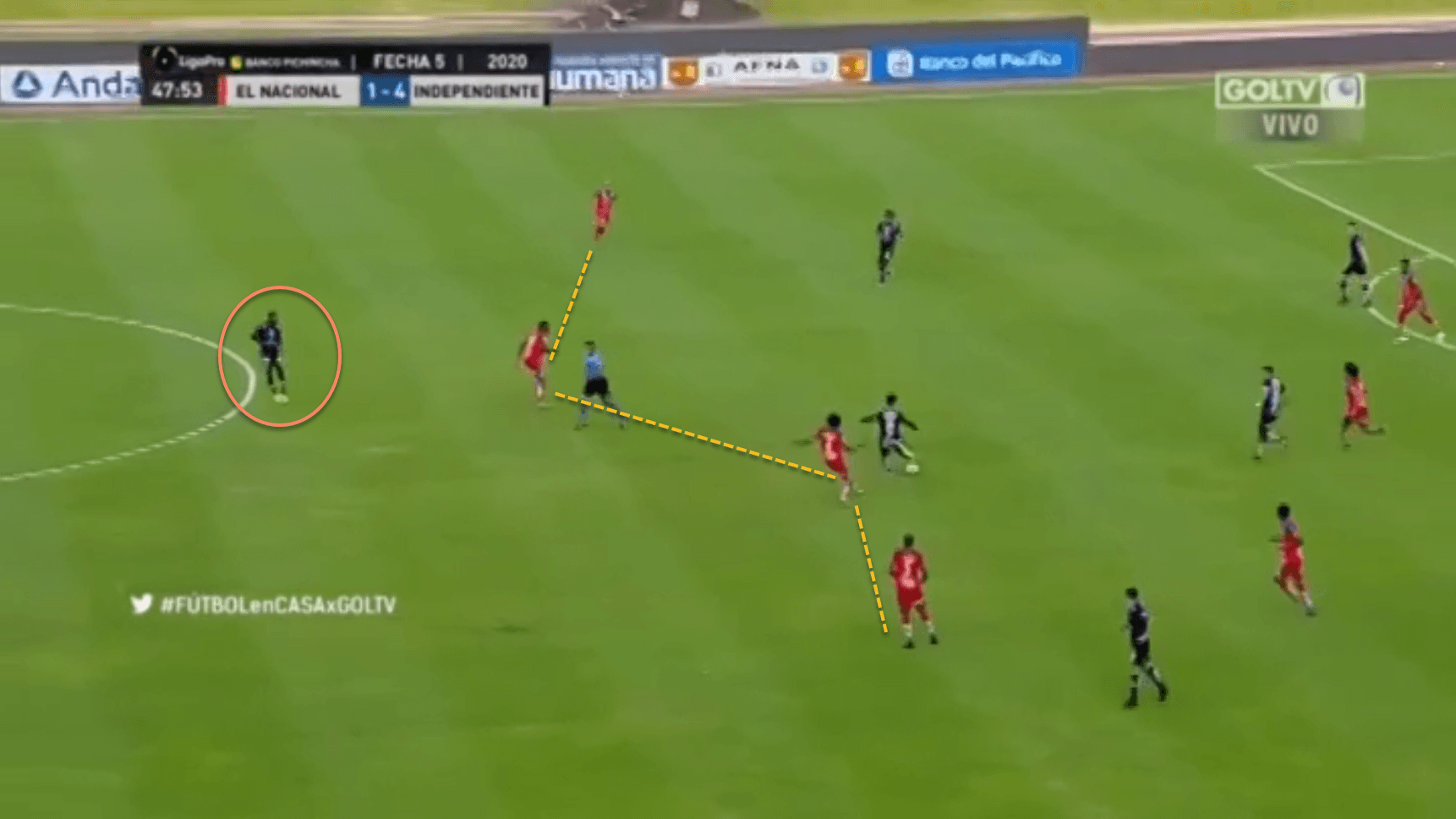
Albeit he is aided by some horrendous pressing by the opposition’s midfield, Caicedo has been able to drift into space, completely unmarked and thus in a position to receive the ball and set up a 3v2 counter-attack.
As we said earlier, he is also not shy of getting into dangerous areas if possible.
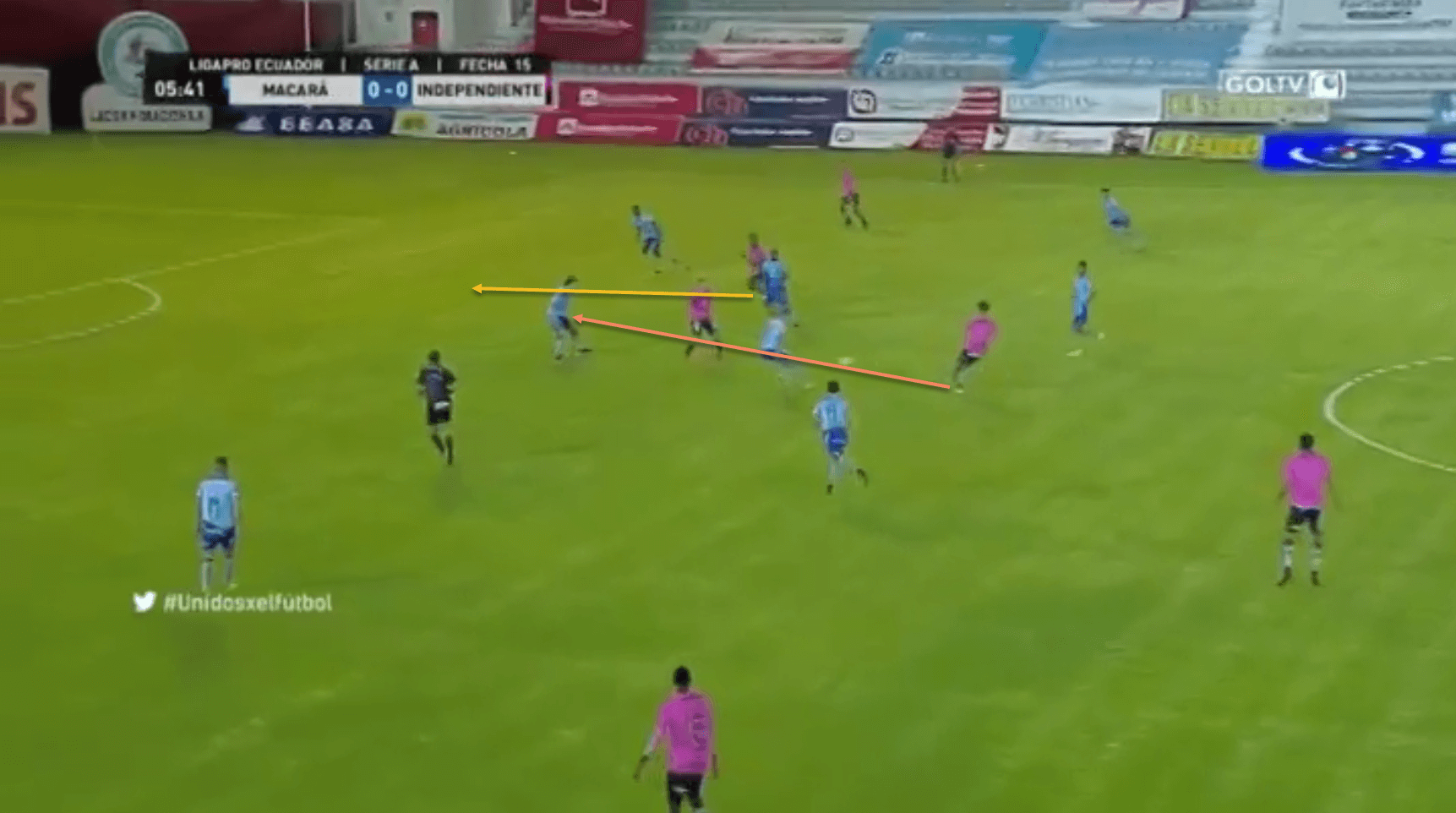
Caicedo (yellow arrow) makes a dangerous run towards the box, which is found by his teammate (orange arrow).
However, when he does get into threatening areas, his end product can leave a lot to be desired.
The 19-year-old is not skilful enough to dribble past opponents, and he does not have the body strength (yet) to barge them off the ball.
This does result in him being dispossessed quite easily in such positions, although he can also win fouls for his team.
His outperformance of his career xG so far by a pretty big margin can be explained by the fact that he usually likes to take long shots from outside the box, which will generally have quite low xG values.
As we saw in the statistics earlier, he rarely takes shots in the first place, and when he does, they are usually from outside the box.
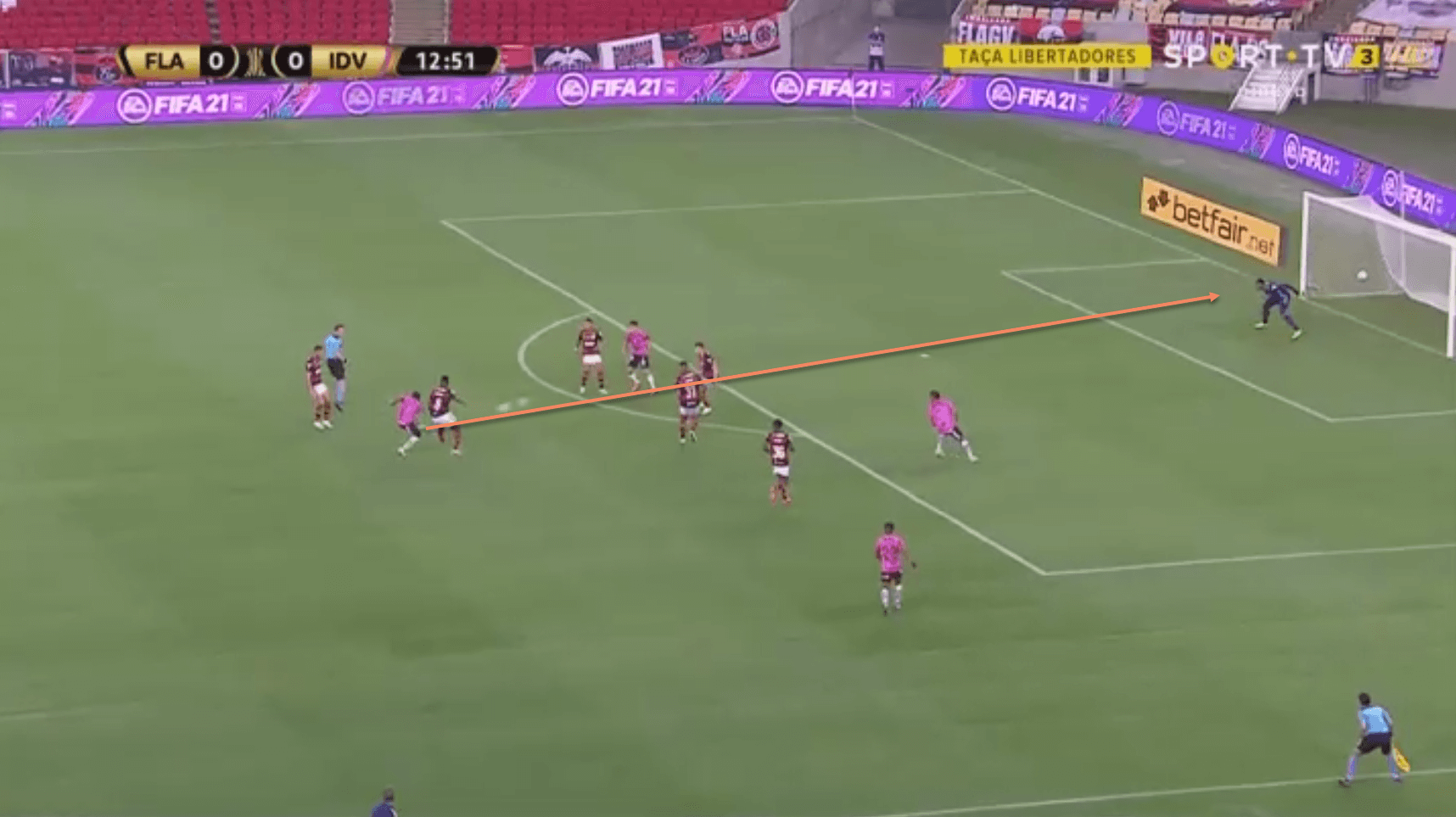
A left-footed effort which drew a decent save from the Flamengo goalkeeper.
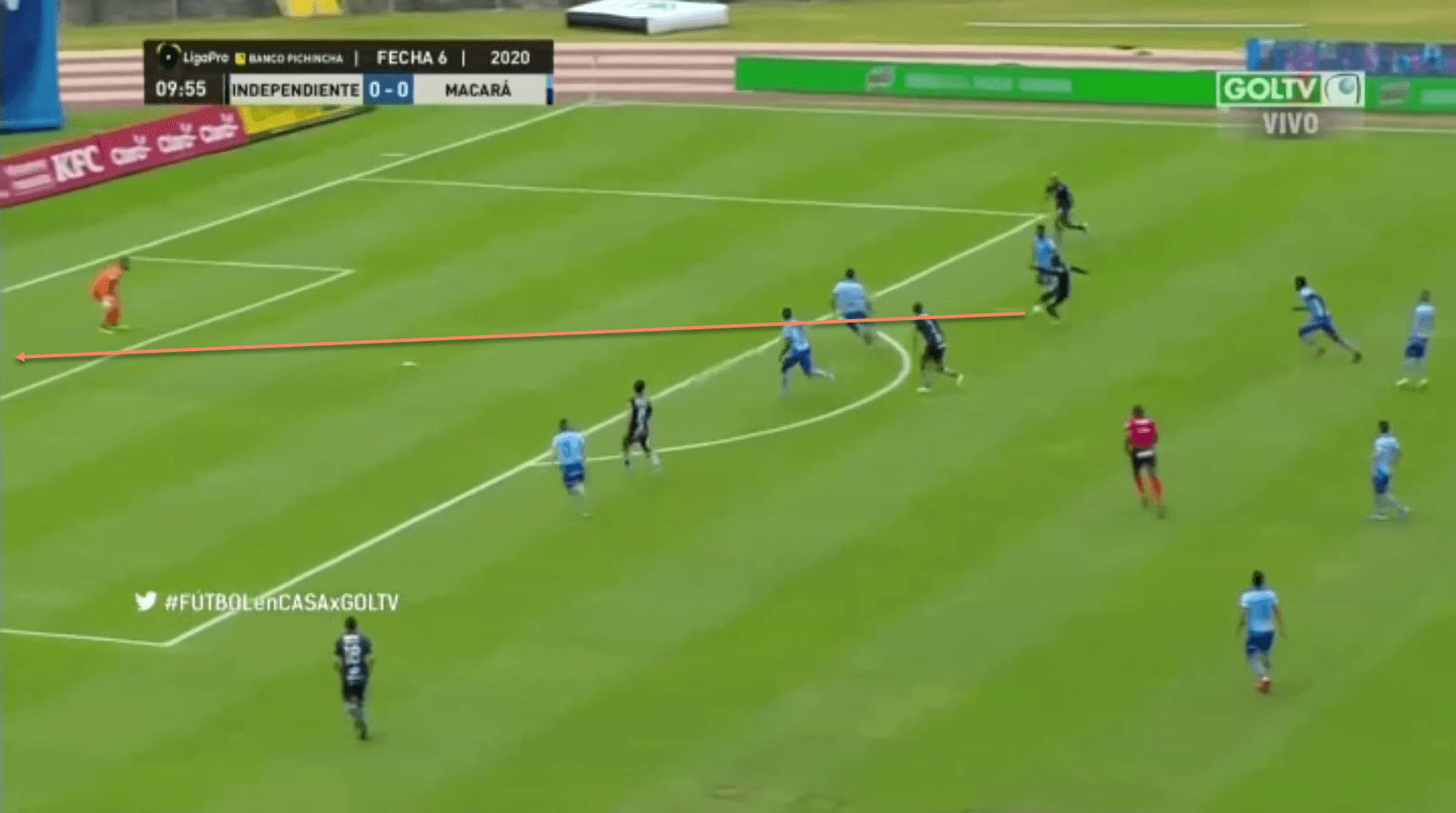
Better luck on this occasion, where he beats the keeper with a fierce drive from outside the box.
Realistically, Caicedo is not going to be scoring too many goals.
He is going to be the player who knits the team together, keeping possession with short, safe passes when needed, but he is capable and willing to switch the tempo with a long pass out wide or into the box to catch the opposition out.
This makes him a very good candidate for teams that will dominate the ball and counter-attacking sides since he has attributes that can be a good fit for both styles of play.
Moises Caicedo Out of possession
As we said earlier, most of Caicedo’s good work when his team does not have the ball comes from his positioning, anticipation, and defensive instincts.
As we will see later, he can perform heroic blocks and challenges, but his intelligence and ability to sniff out danger are far more important when it comes to screening the defence.
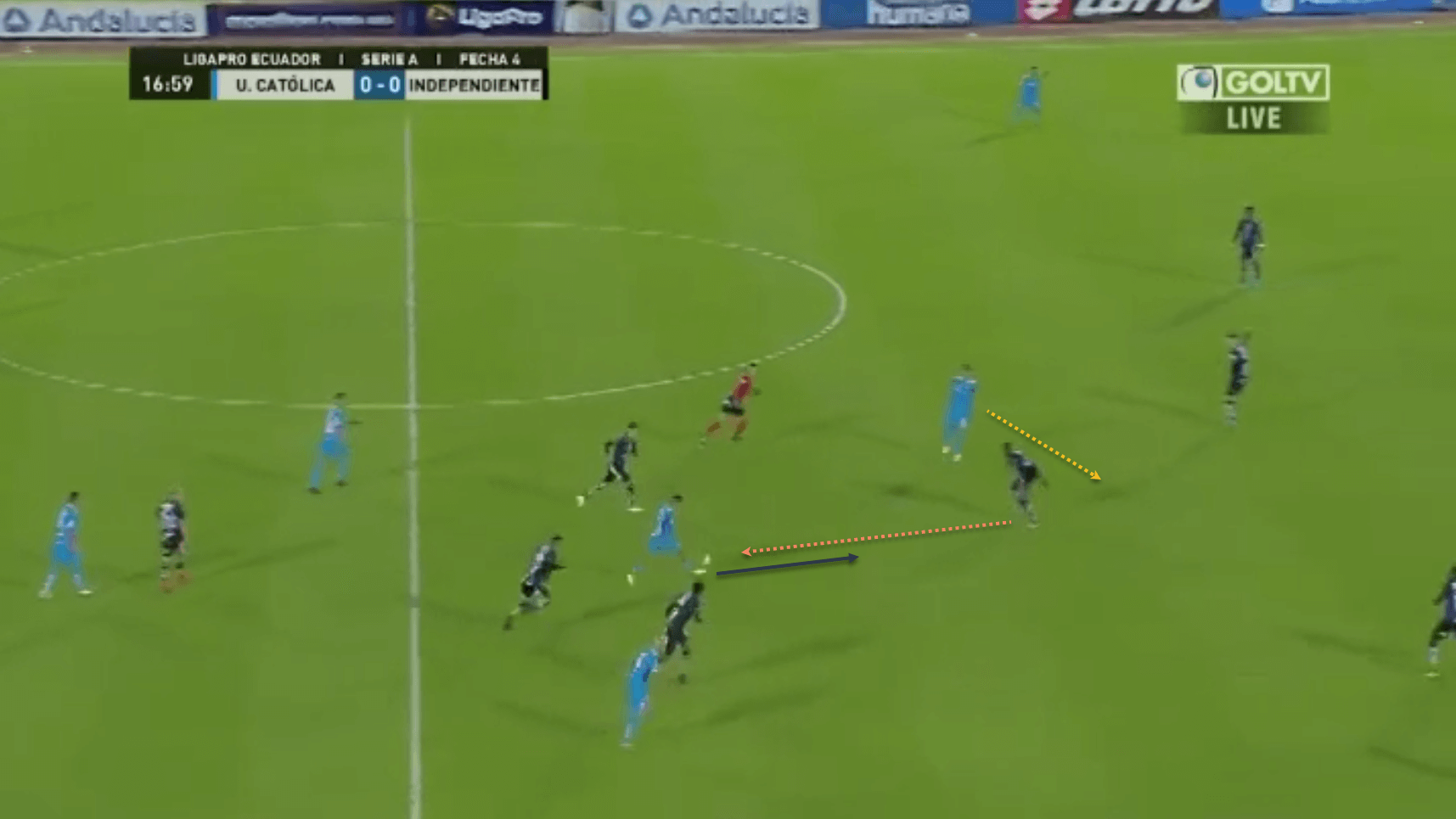
This is a good example of his defensive instincts.
As the opposition’s attack develops, Caicedo can easily get drawn towards the player on the ball (orange path), which would leave a lot of space behind him for the player to his right to get into.
It would also be a simple pass to find him.
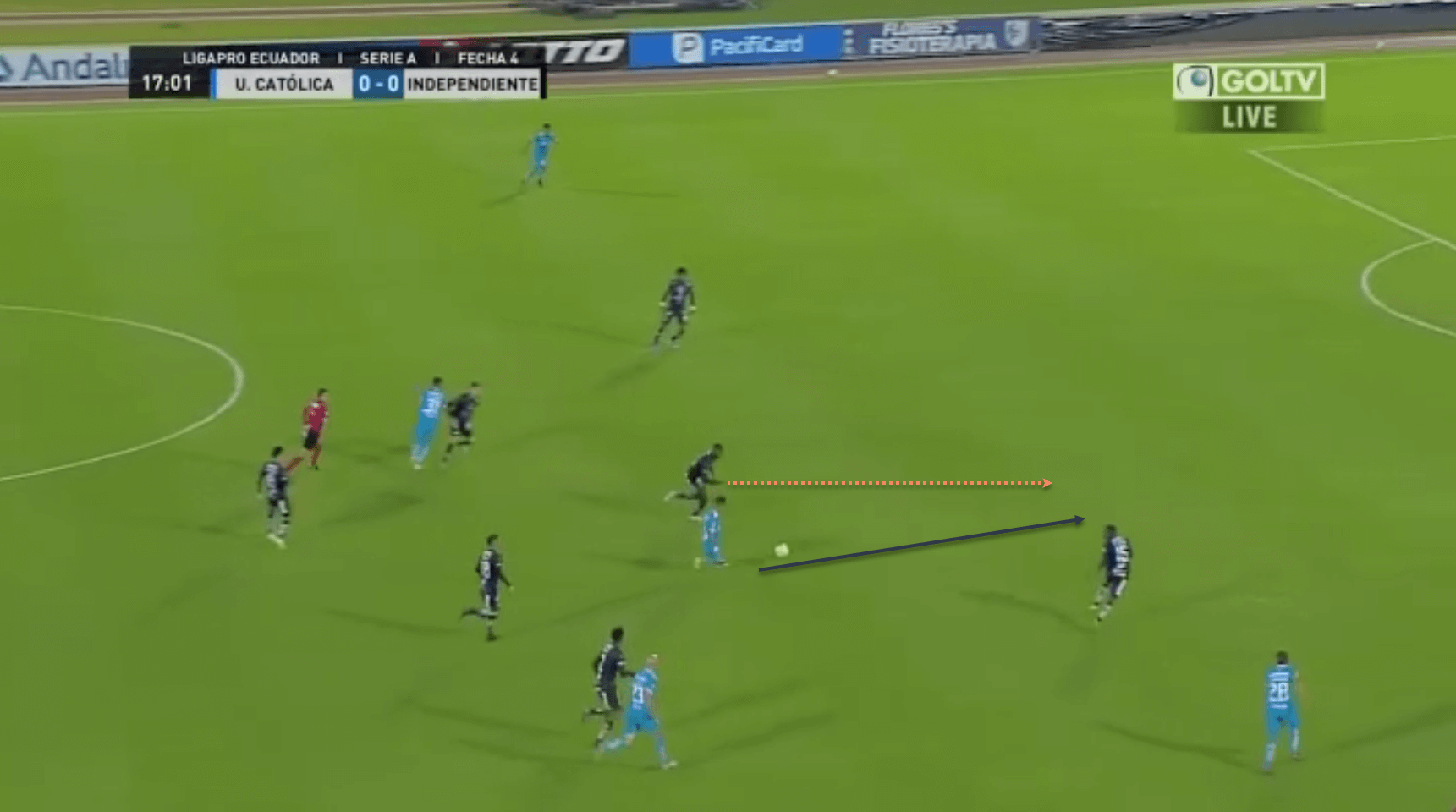
Caicedo does hold his position, with the opposition playing a one-two pass.
However, the fact that he held his position means that he can now track the run rather than being caught advancing and leaving space centrally for the attacker to advance.
This, along with the left-back covering, means that his opponent is forced to play the ball out wide rather than try to get into the box with the ball…
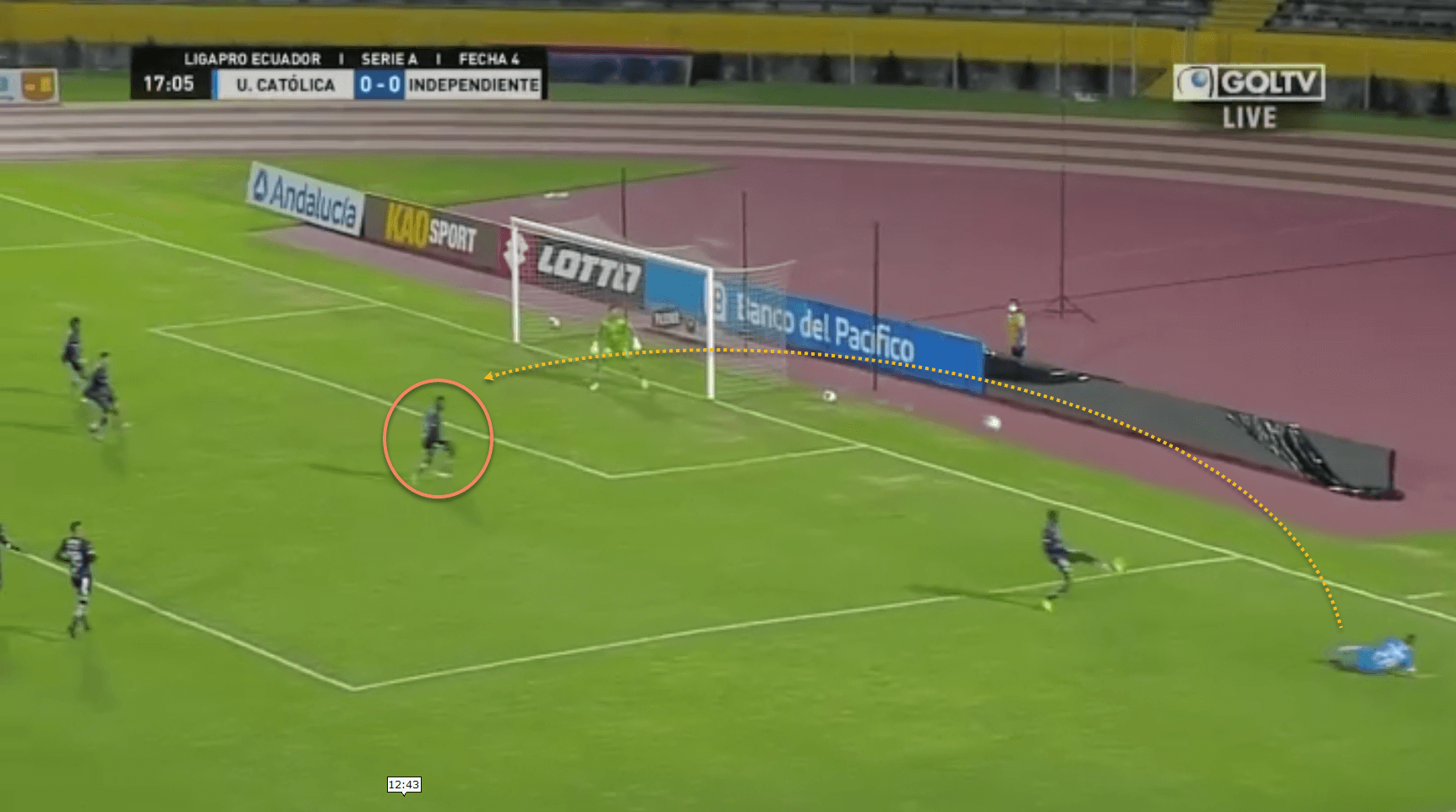
…and it is Caicedo who gets on the end of the attempted cross to head it away from danger.
Note that this was relatively early in this match, and conceding a goal at that time could have changed the complexion of the game.
Therefore, the Ecuadorian shows great defensive awareness, knowing when to hold his position and when to press. He also displays his athleticism in getting back into the box to head the cross away.
In fact, another example from the same game tells us that he does, in fact, know when to be active and go in for a challenge.
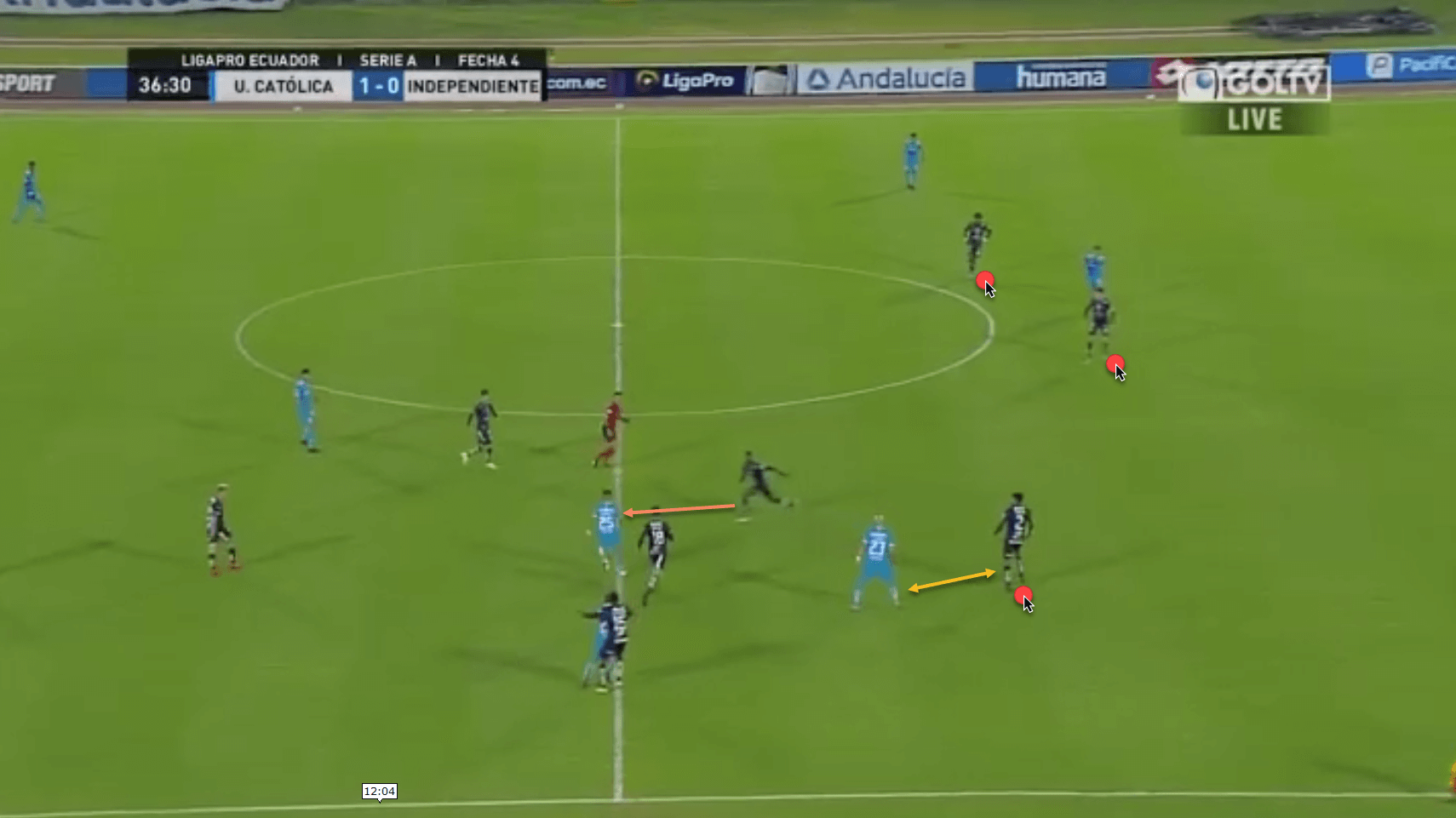
…and it is Caicedo who gets on the end of the attempted cross to head it away from danger.
Note that this was relatively early in this match, and conceding a goal at that time could have changed the complexion of the game.
Therefore, the Ecuadorian shows great defensive awareness, knowing when to hold his position and when to press. He also displays his athleticism in getting back into the box to head the cross away.
In fact, another example from the same game tells us that he does, in fact, know when to be active and go in for a challenge.
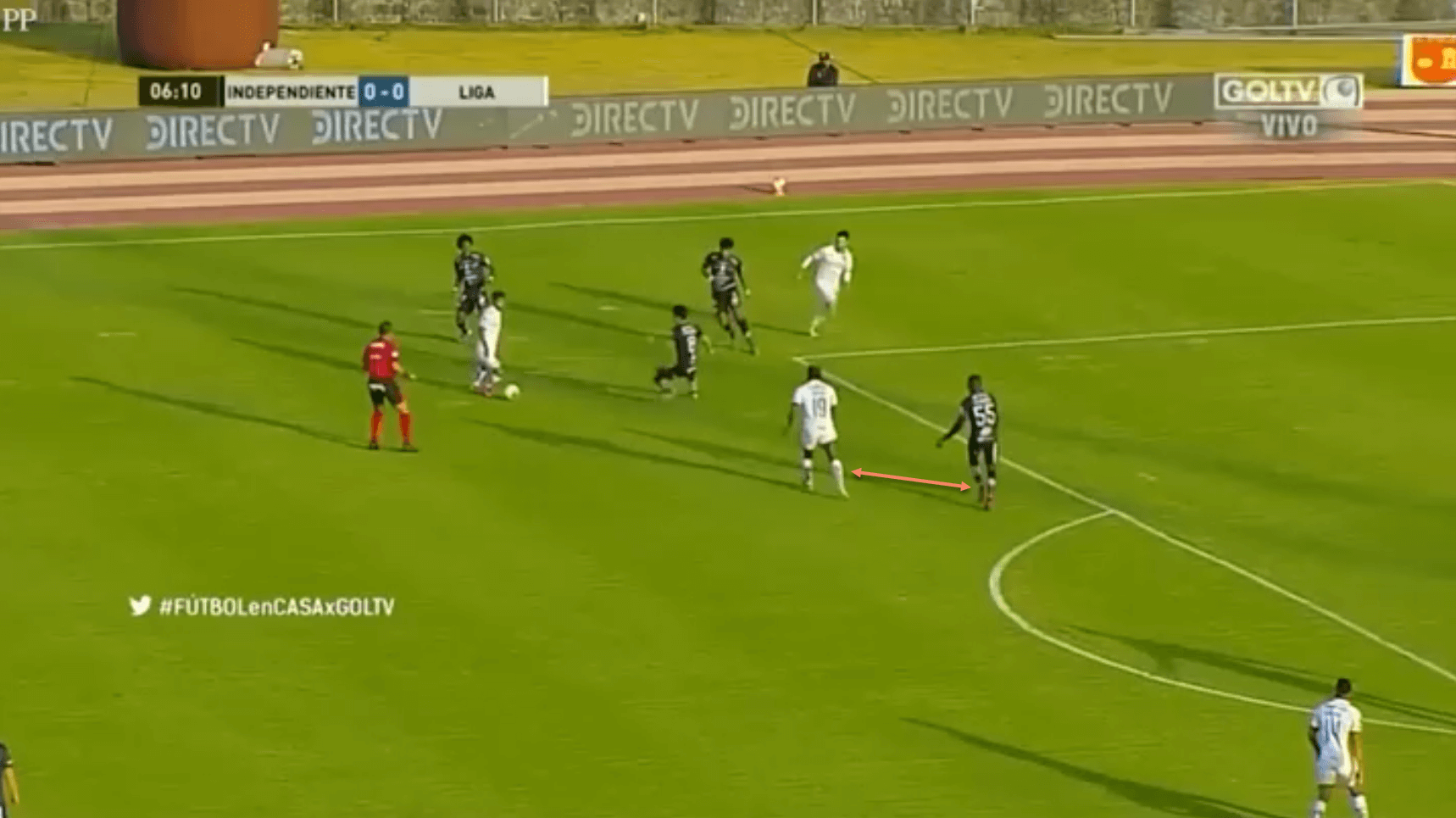
At first glance, this situation seems to be under control.
Caicedo is goalside of his marker and in position to hold him up and, therefore, delay or prevent his movement into the box.
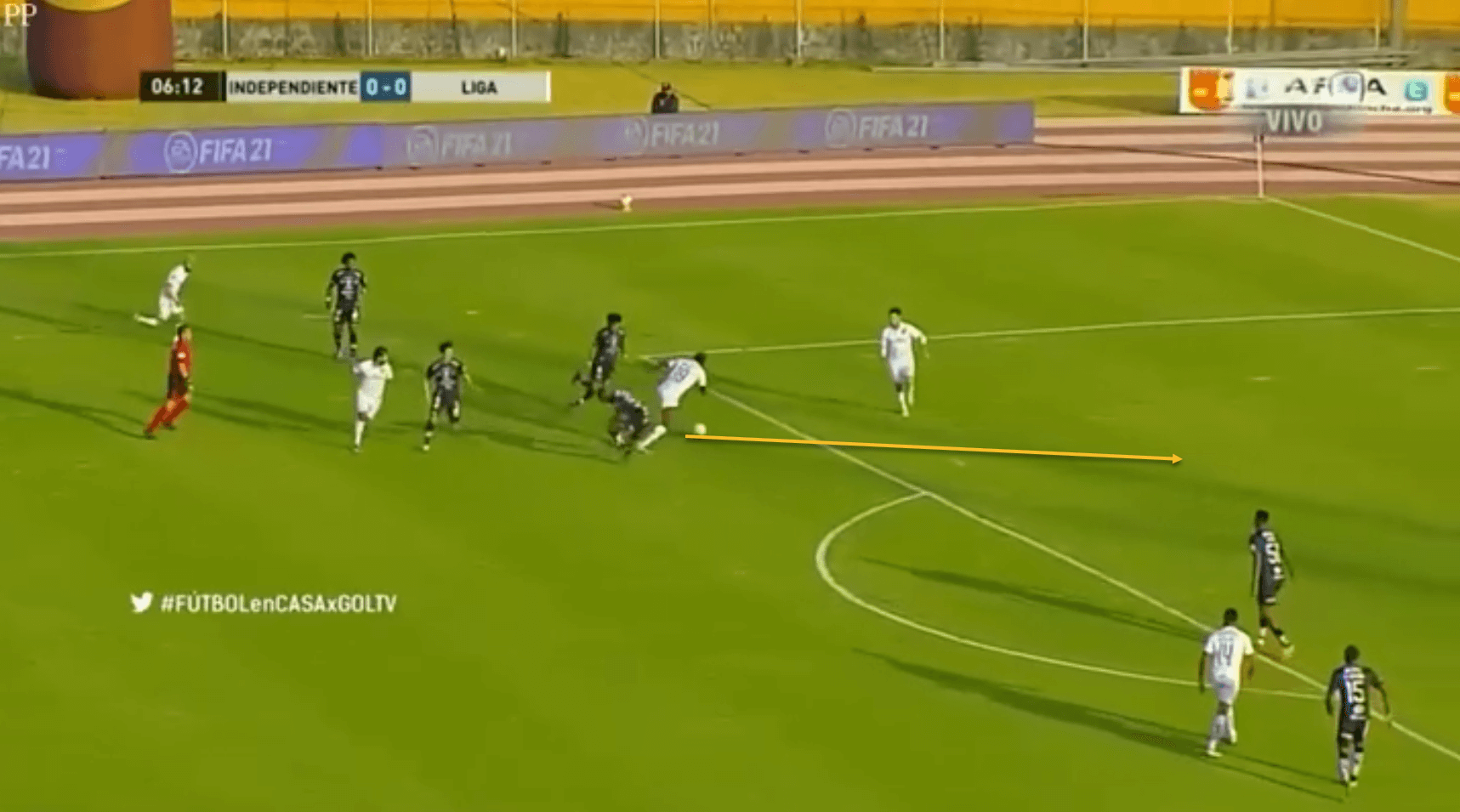
However, he gets tight to the attacker, who uses his strength to get past him and run into the box unimpeded.
He goes on to score from this move – a direct error on the part of Caicedo.
Of course, these physical limitations can be improved to an extent with work in the gym.
It is much more important that Caicedo has the defensive instincts which are crucial for a player in his position, as being quick or strong will usually not be enough to compensate for an error in positioning or timing.
We did say that Caicedo is capable of putting in the ‘spectacular’ tackles and blocks for the cameras.
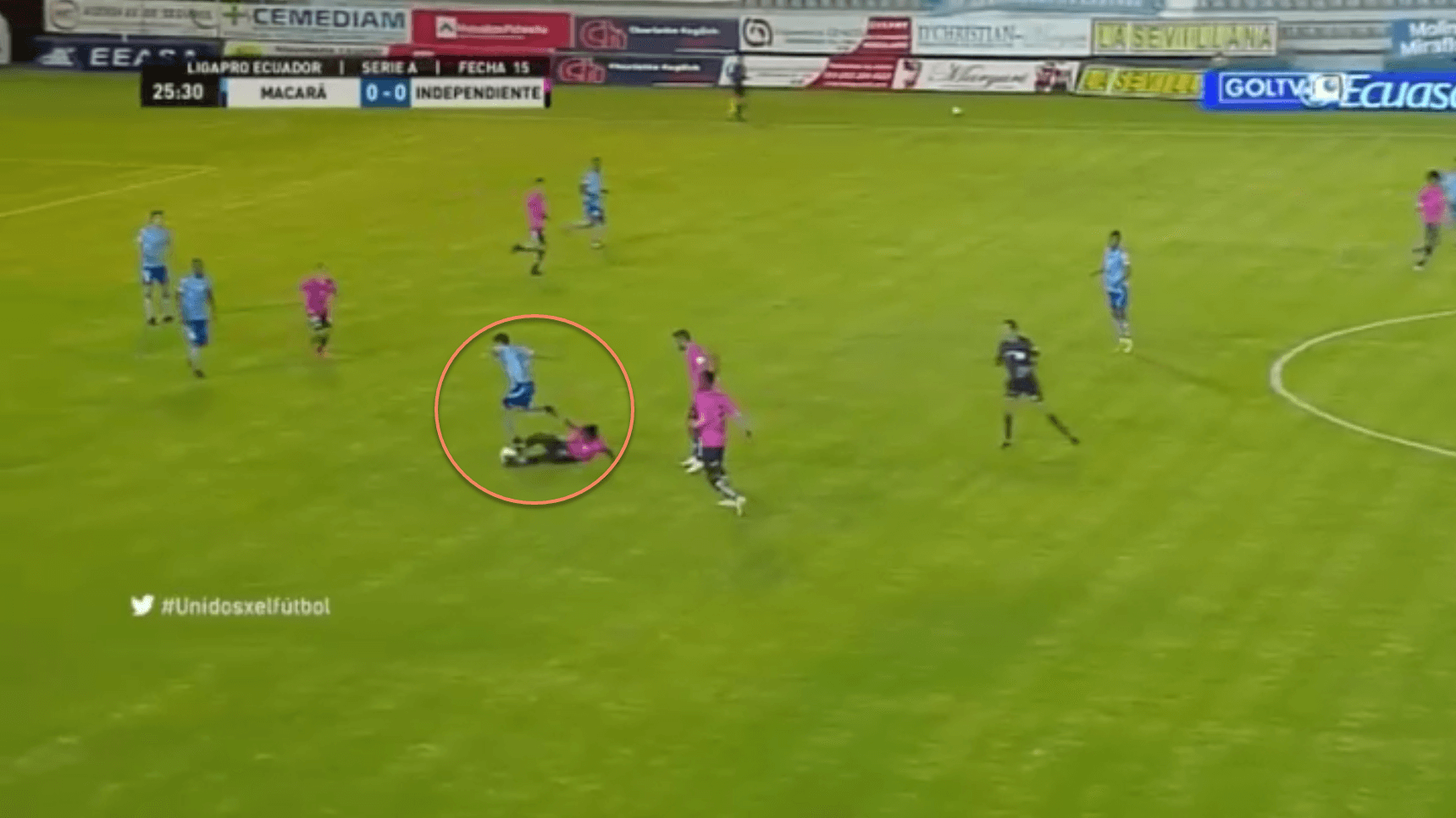
Here, the 19-year-old uses his long legs to win the ball back cleanly despite going to the ground.
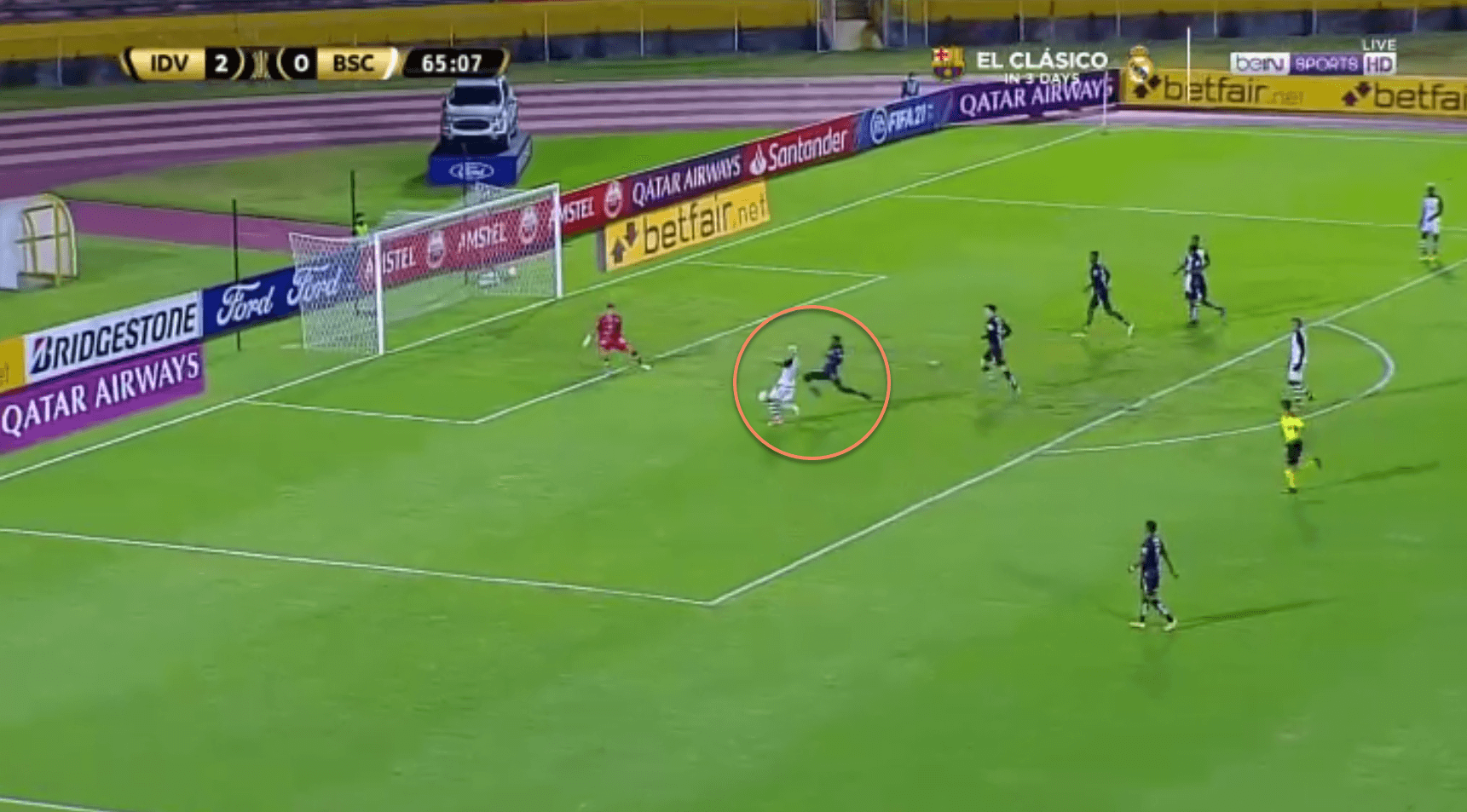
The Ecuadorian flies into a last-ditch block to save what would almost certainly have been a goal.
Conclusion
Moises Caicedo is a gifted young footballer from Ecuador who has been receiving considerable attention from several English clubs in this transfer window.
In terms of his playing style and profile, he is a busy player who is always looking to get involved, especially on the ball, where he is a reliable passer.
He is also capable of increasing the tempo of his team’s play, switching the ball out wide when needed, or even making accurate long passes for runners into the box.
Defensively, he has good instincts, which help him in terms of his positioning as well as decision-making, both of which are critical skills for a defensive midfielder.
He does have the energy to play in a box-to-box role, but he is perhaps best utilised at the base of midfield at present until he fills out a little more and can be a more robust presence higher up the pitch.
Manchester United and Brighton are the two clubs mentioned the most in dispatches, and Caicedo could be a very good option for either club.
His passing range and defensive instincts would make him a good eventual replacement for Matić at Old Trafford, while he could perhaps be an insurance policy for Yves Bissouma‘s departure from the Amex Stadium.
Curiously enough, United have been linked with Brighton’s Malian midfielder as well.
While it remains to be seen where Caicedo ends up and whose place he takes, the Ecuadorian is already at a pretty decent level and can expect to play first-team football in a top European league in the near future.

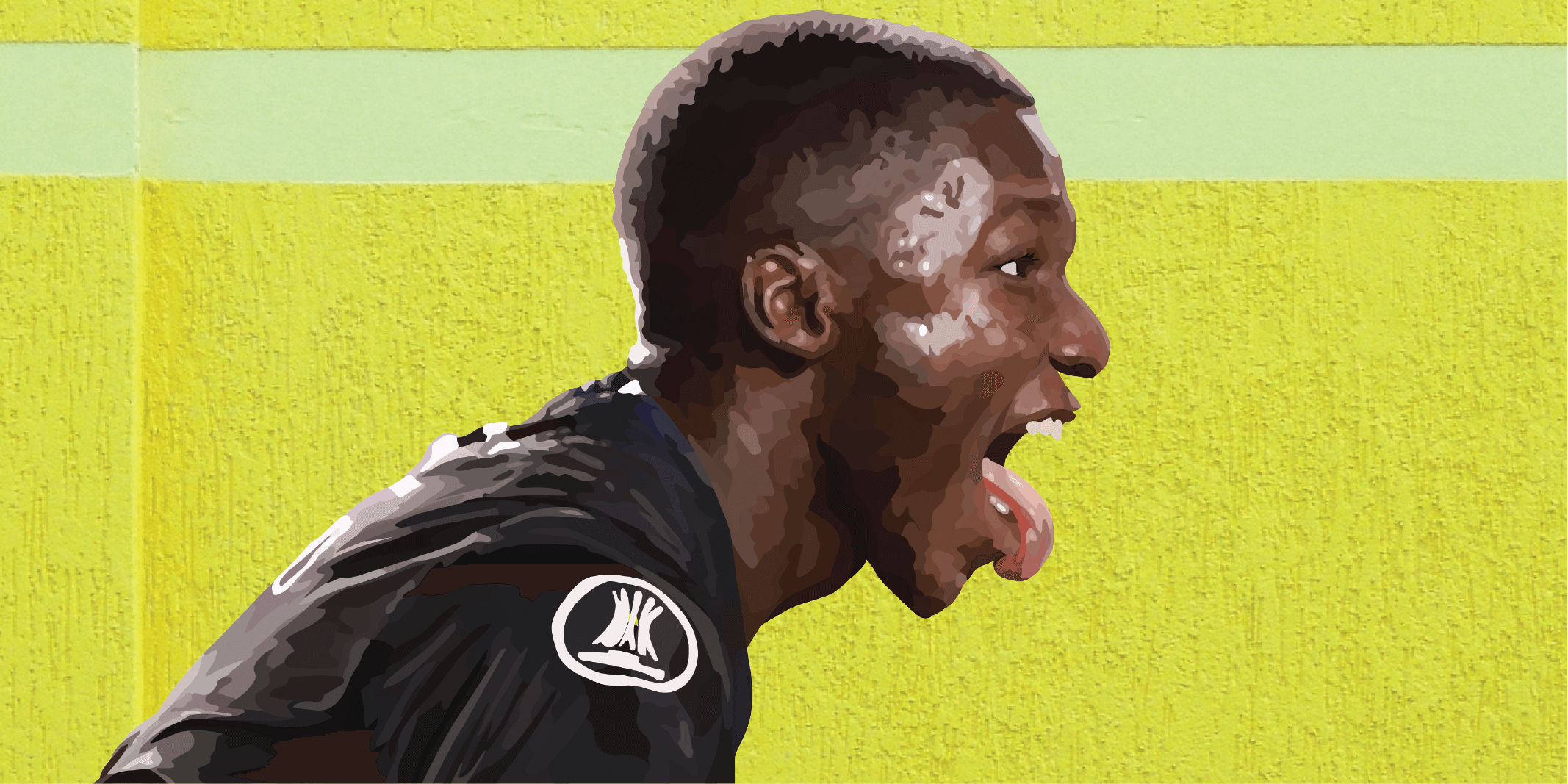



Comments